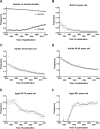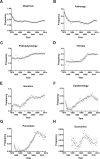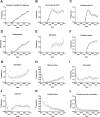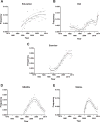Four Decades of Research in Alzheimer's Disease (1975-2014): A Bibliometric and Scientometric Analysis
- PMID: 28671119
- PMCID: PMC6002842
- DOI: 10.3233/JAD-170184
Four Decades of Research in Alzheimer's Disease (1975-2014): A Bibliometric and Scientometric Analysis
Abstract
Background: Bibliometric and scientometric methods can be applied to the study of a research field.
Objective: We hypothesized that a bibliometric and scientometric analysis of the Alzheimer's disease (AD) research field could render trends that provide researchers and funding agencies valuable insight into the history of the field, current tendencies, and potential future directions.
Methods: We performed searches in publicly available databases including PubMed, Scopus, Web of Science, and Alzheimer's Funding Analyzer for the period 1975-2014, and conducted a curve fitting analysis with non-linear regression.
Results: While the rate and impact of publications continue to increase, the number of patents per year is currently declining after peaking in the late 2000s, and the funding budget has plateaued in the last 5-10 years analyzed. Genetics is the area growing at a fastest pace, whereas pathophysiology and therapy have not grown further in the last decade. Among the targets of pathophysiology research, amyloid-β continues to be the focus of greatest interest, with tau and apolipoprotein E stagnant after a surge in the 1990s. The role of inflammation, microglia, and the synapse are other research topics with growing interest. Regarding preventative strategies, education attainment, diet, and exercise are recently gaining some momentum, whereas NSAIDs and statins have lost the spotlight they once had.
Conclusion: Our bibliometric and scientometric analysis provides distinct trends in AD research in the last four decades, including publication and patent output, funding, impact, and topics. Our findings could inform the decision-making of research funding agencies in the near future.
Keywords: Alzheimer’s disease; amyloid-β peptides; bibliometrics; h-index; neurofibrillary tangle; scientometrics; tau proteins.
Figures








Similar articles
-
A Bird's-Eye View of Alzheimer's Disease Research: Reflecting Different Perspectives of Indexers, Authors, or Citers in Mapping the Field.J Alzheimers Dis. 2015;45(4):1207-22. doi: 10.3233/JAD-142688. J Alzheimers Dis. 2015. PMID: 25697702
-
Bibliometric and scientometric analysis of PSMA-targeted radiotheranostics: knowledge mapping and global standing.Front Oncol. 2024 Jul 1;14:1397790. doi: 10.3389/fonc.2024.1397790. eCollection 2024. Front Oncol. 2024. PMID: 39011478 Free PMC article.
-
Curare--a curative poison: a scientometric analysis.PLoS One. 2014 Nov 19;9(11):e112026. doi: 10.1371/journal.pone.0112026. eCollection 2014. PLoS One. 2014. PMID: 25409503 Free PMC article.
-
The Third French Alzheimer Plan: analysis of the influence of a national public health initiative on scientific research productivity and impact.Alzheimers Res Ther. 2015 Sep 26;7(1):60. doi: 10.1186/s13195-015-0144-z. Alzheimers Res Ther. 2015. PMID: 26407550 Free PMC article.
-
The association between toxic pesticide environmental exposure and Alzheimer's disease: A scientometric and visualization analysis.Chemosphere. 2021 Jan;263:128238. doi: 10.1016/j.chemosphere.2020.128238. Epub 2020 Sep 4. Chemosphere. 2021. PMID: 33297185 Review.
Cited by
-
Bibliometric analysis of global research on the role of apolipoprotein E in Alzheimer's disease.Heliyon. 2023 Jul 5;9(7):e17987. doi: 10.1016/j.heliyon.2023.e17987. eCollection 2023 Jul. Heliyon. 2023. PMID: 37496906 Free PMC article. Review.
-
Editorial: The Role of Glia in Alzheimer's Disease.Front Neurol. 2019 Jan 11;9:1161. doi: 10.3389/fneur.2018.01161. eCollection 2018. Front Neurol. 2019. PMID: 30692961 Free PMC article. No abstract available.
-
Thematic research clusters in very old populations (≥ 80 years): a bibliometric approach.BMC Geriatr. 2021 Apr 21;21(1):266. doi: 10.1186/s12877-021-02209-7. BMC Geriatr. 2021. PMID: 33882849 Free PMC article.
-
Research trends and hotspots for frontotemporal dementia from 2000 to 2022: a bibliometric analysis.Front Neurol. 2024 Jul 17;15:1399600. doi: 10.3389/fneur.2024.1399600. eCollection 2024. Front Neurol. 2024. PMID: 39087008 Free PMC article.
-
A Bibliometric Review on Gut Microbiome and Alzheimer's Disease Between 2012 and 2021.Front Aging Neurosci. 2022 Jul 11;14:804177. doi: 10.3389/fnagi.2022.804177. eCollection 2022. Front Aging Neurosci. 2022. PMID: 35898324 Free PMC article.
References
-
- Katzman R. Editorial: The prevalence and malignancy of Alzheimer disease. A major killer. Arch Neurol. 1976;33:217–218. - PubMed
-
- Alzheimer’s Association. 2015 Alzheimer’s disease facts and figures. Alzheimers Dement. 2015;11:332–384. - PubMed
-
- Department of Health, United Kingdom. The Ministerial Advisory Group on Dementia Research: Headline Report 2011
-
- Le Duff F, Develay AE, Quetel J, Lafay P, Schück S, Pradier C, Robert P, French National Alzheimer dataBank (BNA) The 2008-2012 French Alzheimer plan: Description of the national Alzheimer information system. J Alzheimers Dis. 2012;29:891–902. - PubMed
-
- Khachaturian ZS, Khachaturian AS, Thies W. The draft “National Plan” to address Alzheimer’s disease -National Alzheimer’s Project Act (NAPA) Alzheimers Dement. 2012;8:234–236. - PubMed
MeSH terms
Grants and funding
LinkOut - more resources
Full Text Sources
Other Literature Sources
Medical

